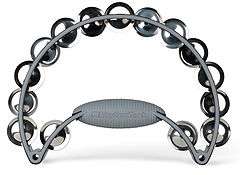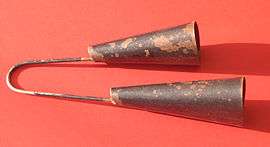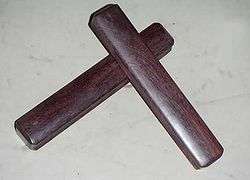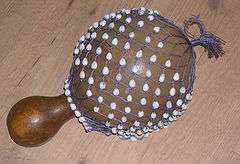Hand percussion

Modern Tambourine
Half moon tambourine rhythms | |
| Problems playing this file? See media help. | |
Hand percussion is a term used to indicate a percussion instrument of any type from any culture that is held in the hand. They can be made from wood, metal or plastic and are usually either shaken, scraped or tapped with fingers or a stick. It is a useful category in terms of a large percussion orchestra in that it identifies all instruments that are not drums or pitched percussion such as marimba and xylophone.
Shakers
Caxixi
Large and small caxixi played together | |
| Problems playing this file? See media help. | |
Shekere
Basic groove on shekere | |
| Problems playing this file? See media help. | |
A shaker (percussion) is any instrument that makes a noise when shaken. Historically they were naturally occurring items such as seed pods.A caxixi is a basketwork shaker with a gourd base. Gourds are used all over the world and covered with a net with shells or seeds to create an instrument such as the shekere. Modern shakers are often cylinders made from metal wood or plastic containing small hard items such as seeds, stones, or plastic - an example is the Egg Shaker.There is another category of shaken instrument using jingles, little discs of metal which tap together when shaken. Tambourines fall into this category.
Scrapers

Modern Guiro
Sounds of the guiro | |
| Problems playing this file? See media help. | |

This can be a wood, metal or plastic instrument which has ridges on its body. Often known as Guiro, rhythms are created by running a thin stick up and down the ridges at different speeds. Gourds or bamboo have traditionally been used as they have a resonant hollow body and can easily be cut with ridges. A common type from Asia is a carved wooden frog which has ridges cut on its back and its mouth and belly hollowed out.
Cowbells

Modern agogo
modern agogo rhythm pattern | |
| Problems playing this file? See media help. | |
Cowbell
Cowbell pattern | |
| Problems playing this file? See media help. | |
Cowbells originate from the bells tied around the necks of livestock. They are any type of hand held bell tapped with fingers, wood or metal. They occur all over the world and are used extensively in Latin Percussion music and often found as part of a standard Rock Drum Kit. The name cowbell usually refers to a single bell. The Agogô bell usually refers to a double or triple bell.
Triangles

Latin style triangle
A triangle played latin style, opening and closing the hand for rhythmic effect. | |
| Problems playing this file? See media help. | |
The triangle is a piece of steel bent in the shape of a triangle tapped with another piece of steel. It is suspended on one hand which can be open and closed to alter the sound. Very commonly used in South American Music to give a persistent high pitched pulse.
Sticks

Claves
Clave pattern | |
| Problems playing this file? See media help. | |
Tapping two sticks together is the simplest form of hand percussion, and has developed a place in traditional music all over the world. Indigenous Australians use clapping sticks alongside the didgeridoo, and claves are an integral part of South American Music.
Small drums
There are a variety of small hand held drums such as tamborim which fall into the Hand Percussion category.
Listening
 |
Güira
Güira sounds. |
| Problems playing this file? See media help. | |
 |
Altogether now
hand percussion ensemble |
| Problems playing this file? See media help. | |

